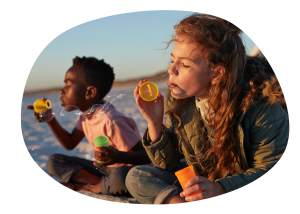What Should You Do if Your Child Is a Bully?

Bullying is a common occurrence in schools regardless of the ages of students. According to the Centers for Disease Control and Prevention (CDC), reports of bullying are highest in middle schools (28%) followed by high schools (16%), combined schools (12%) and primary schools (9%). And while bullying often happens at school, children and teens are vulnerable to bullies anywhere. Cyberbullying is on the rise, with Pew Research Center data showing that about 6 in 10 teens have been bullied or harassed online.
“Bullying is not normal, natural or necessary,” said Barbara Coloroso, speaker and author of The Bully, the Bullied, and the Not-So-Innocent Bystander. “You have to learn to be mean to someone else.”
But if it’s a learned behavior, Coloroso believes it can also be unlearned. And parents who discover that their child is bullying someone else can play an important part in putting an end to the inappropriate behavior. Below, we will cover effective strategies for parents, teachers and students to address bullying.
Which Kids Are Most Likely to Bully Others?
Bullying starts earlier than most people might think—at age 4 ½ for girls and 5 for boys, Coloroso said. The reason for this is that the majority of bullying is verbal, and girls tend to be more verbal at a younger age. An example of bullying at this age might be a child saying, “You can’t come to my birthday party.”
Coloroso makes the distinction between three types of bullying:
Verbal – the most common type among both boys and girls, which includes name-calling, racial or sexual slurs, or mocking of a person’s appearance or differences.
Physical – the least common but most visible type of bullying, which more often occurs among boys than among girls.
Social or relational – this type includes gossip, rumors and exclusion and tends to be more common among girls.
There is not just one profile of a child who engages in bullying behavior, according to StopBullying.gov. Kids who bully can be popular or marginalized. Sometimes, kids who are bullied also bully others.
Here are three common characteristics of bullies:
- An attitude of entitlement to control, dominate, subjugate, or otherwise abuse another person.
- An intolerance toward differences.
- A mistaken assumption that they have the liberty to exclude someone not deemed worthy of respect or care.

Why Do Kids Bully?
StopBullying.gov highlights the different reasons why kids may bully, which include these contributing factors:
Peer factors: the desire to raise their status in their peer group or maintain social power by excluding others.
Emotional factors: insecurity, low self-esteem or the inability to manage their emotions.
Family factors: a homelife where aggression and domestic violence are common, or where parents are too indulgent or uninvolved in their children’s lives.
“Bullying tends to run in the family,” Coloroso said. If that makes parents defensive or uncomfortable, she advises they consider whether the child has seen bullying behavior modeled. How do they treat domestic workers or people in the service industry? How about the new neighbor who dresses differently?
“Your children are watching. They’re great observers of our behavior,” she said, adding that kids can also learn bullying in daycare or school, or from the media they’re exposed to.
Different Types of Bullies
Just as there is not one type of child who bullies, there is not just one type of bully. Dan Olweus, creator of the Olweus Bullying Prevention Program, developed the concept of “the bullying circle” (PDF, 18KB), which highlights the different participants and bystanders involved in a bullying situation, including the following:
The Bully: The person who starts and takes an active part in the bullying.
The Henchmen: The people who take an active part in the bullying but don’t plan or start it.
Active and Passive Supporters: The people who cheer the bully on or enjoy the bullying but do not show open support.
Onlookers and Witnesses: The people who dislike the bullying and think they should help, but don’t.
Resister/Defender: The person who actively speaks out and stands up to the bully, helps the target.
Regardless of a child’s role, bullying can affect everyone involved. According to StopBullying.gov, children who are bullied may experience physical, social, emotional, academic and mental health problems. Children who witness bullying may also experience mental health problems and higher student absenteeism.
The website also notes that children who bully are more likely to engage in these behaviors:
- Alcohol and other drug abuse in adolescence and adulthood.
- Fights, vandalism and dropping out of school.
- Early sexual activities.
- Abusive behavior toward their partner, spouse or children as an adult.

How to Stop Bullying
Parents, teachers, school social workers and other caring adults all play a role in preventing and stopping bullying. Here are some important things to keep in mind.
Conflict vs. Contempt
Adults who witness or hear about bullying should intervene immediately, Coloroso said. It’s easier to stop bullying in the early stages—emphasis on the word “stop.” Too often, students who have bullied and the classmates who they bullied are forced into conflict resolution workshops.
However, Coloroso explains that “it’s important to remember that bullying is not about anger or conflict; it’s about contempt. Conflicts you resolve, bullying you stop.”
Conflict
an active disagreement or fight between people with opposing views.
Contempt
a feeling of dislike toward somebody considered to be worthless, inferior and undeserving of respect.
Punishment vs. Discipline
Coloroso also makes the distinction between punishing and disciplining a bully. There are many examples of the former on social media, such as parents who force their child to hold a sign saying “I am a bully” on a busy street corner. But shaming isn’t an effective way to change behavior, and it can have harmful consequences. Here’s how Coloroso differentiates between punishing and disciplining a child:
Punishment
doing something to a child that may damage the child’s self-esteem.
Discipline
doing something with a child that gives them ownership of what they’ve done wrong and ways to solve it, which leaves the child’s dignity intact.
“Our job is to humble—not humiliate—the bully and empower the targeted child,” she said.
Developing positive behavioral interventions and assisting with conflict resolution for students who may exhibit bullying behaviors are among a school social worker’s many duties. Learn more about how to become a school social worker and what school social workers do to create better learning environments for children.

How to Handle a Bully
So what does work when dealing with a child who bullies? According to Coloroso, effective discipline must include the Three R’s.
The 3 R’s
Restitution: Have the child own and fix what they did. For example, the child who broke a classmate’s favorite pencil on purpose must replace it. An apology is also in order, but it must not be forced. An insincere “I’m sorry” solves nothing.
Resolution: Help the child figure out how to keep it from happening again. If the child felt jealous or angry and broke a classmate’s pencil, adults may need to help them work through their feelings and figure out more constructive ways to handle them.
Reconciliation: Encourage the child to heal with the person they harmed, if that person is willing—though they might not be.
There are several other strategies that can help address bullying behaviors in children. Coloroso suggests these tactics:
Create opportunities to do good.
The more a child can behave in caring and helpful ways toward others, the less likely they will be to want to treat others with disregard.
Nurture empathy.
“Empathy is an inborn quality in human beings,” writes Coloroso. Yet bullies tend to see incidents only from their own point of view and be concerned only with their own feelings. It may take time and effort to uncover or restore their empathy.
Teach friendship skills.
A child may have resorted to bullying because they couldn’t figure out another way to make friends. To have friends, we need to be a friend, writes Coloroso. “One of the strongest buffers a child can have against being a bully is being a good friend.”
Engage in more constructive, entertaining and energizing activities.
The more of these activities a child engages in, the less time they will have to bully anyone else.
Just because a child has engaged in bullying behaviors does not mean there’s no hope for reform, Coloroso explains. “It is never too late to change the dynamics. Just as the student was capable of being disrespectful and malicious and callous, so is she capable of being respectful, kind, and compassionate.”
This article is for informational purposes only. If you are concerned about the behaviors that a child is displaying, a social worker, psychologist, behavioral specialist or counselor may be able to offer support.
Bullying Resources for Parents, Educators and Students
- Kids Are Worth It! Author, speaker and bullying expert Barbara Coloroso’s website includes articles, podcasts, handouts and a free, downloadable Essential Guide for Educators on Bullying (PDF, 3 MB), adapted from her book The Bully, the Bullied, and the Not-So-Innocent Bystander.
- Bullying and Cyberbullying: How Parents and Teachers Can Detect, Prevent and Stop Bullying, Implementing the Right Strategies, by Anna Maria Di Marzo. This book explains the causes and consequences of school bullying and why parents and teachers must master intervention strategies.
- Violence and Bullying in Schools: Tips for Students and Social Workers (PDF, 3 MB), The National Association of Social Workers (NASW) Practice Perspectives. This article provides actions social workers can take to help prevent school violence and bullying.
- Olweus Bullying Prevention Program, developed by Dr. Dan Olweus, a research professor of psychology from Norway, has been studied and found effective in reducing bullying. Learn more about the program and how to implement it in your school.
- 8 Reasons Why Teens Bully Others, Verywell Family. It’s important to understand the reasons behind bullying behavior in order to address it.
- What to Do If Your Child Is Bullying Other Kids, Empowering Parents. Article author James Lehman, MSW, offers parents advice for teaching their children what bullying is, skills to stop it and consequences for bullying behavior.
- Why Do Kids Bully? Parents.com. Four tips for parents to assess their child’s actions without judgment, understand their behavior and decide on the appropriate consequences.
- StompOutBullying.org is a leading national nonprofit dedicated to reducing and preventing bullying, discrimination and violence in schools, online and in communities across the country. Offers a confidential HelpChat Line for youth ages 13-24.
- StopBullying.gov is a website managed by the U.S. Department of Health and Human Services that provides information from various government agencies on what bullying is, what cyberbullying is, who is at risk and how to prevent and respond to bullying.
- Youth Violence Resources, CDC, offers fact sheets, reports and more about bullying from the Centers for Disease Control and Prevention.
Resources to Address Cyberbullying
- ConnectSafely.org: A Parent’s Guide to Cyberbullying. A robust resource, downloadable in PDF form, from a nonprofit dedicated to safety, privacy, security and digital wellness education.
- Cyberbullying Research Center. Resources, statistics and presentations for youth, parents and educators are available on their website or via in-person events.
- Ditch the Label: Global Youth Charity. This organization supports people aged 12-25 throughout the world on challenging issues including cyberbullying, mental health, relationships and identity.
- Enough Is Enough (EIE): Making the Internet Safer for Children and Families. Since 1994, this nonprofit has been on the front lines of raising public awareness about the harms of internet pornography, sexual predators, cyberbullying, sex trafficking and other dangers.
- National Crime Prevention Council (NCPC): Cyberbullying Information, Training and Resources. Download cyberbullying flyers, posters, tip sheets, podcasts and a PowerPoint training produced by the NCPC and the Office for Victims of Crime to share with your school community.
- Security.org: Cyberbullying Statistics and Resources. Review this updated list of statistics on cyberbullying risks, prevalence and impact so you can be informed to take action.

